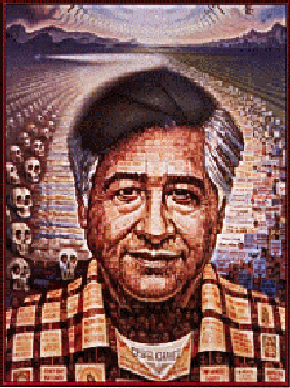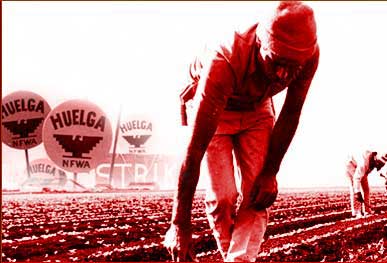
Organizations
Notes
Cesar Chavez has become an iconic figure to Latinos nationally, and the organizations which he spearheaded have continuously helped numerous minorities and migrant workers in dire situations.
Chavez's initiation into political life came in 1952, when he was asked to join the Community Service Organization by its founder, Fred Ross. The organization was the catalyst in forming Chavez's own ideas about community mobilization, as Chavez and Ross organized 22 CSO chapters all across California . Ideally, they were hoping to “help Latinos become citizens, register them to vote, battle police brutality and press for paved streets and other barrio improvements.”(13) The CSO had been a success and, nearly overnight, it became “the most militant and effective Latino civil rights group of its day.”(14) Eventually, Chavez decided to move out of the group and focus his attention on the newly created National Farm Workers Association. Thus, on March 31, 1962 , 10 years after joining the CSO, Chavez resigned.
Chavez would not stay out of the political arena for long. On September 30, 1962 his newly formed group, The National Farm Workers Association, first convened in Fresno , California . Chavez, growing up as a migrant worker, had experienced the everyday plight of workers associated with the large, fruit-growing corporations. As a result, he created the NFWA, which would be a voice for the destitute that had continuously been exploited. The group became famous in the 1960's for the numerous strikes, boycotts, and walkouts against big grape, lettuce, and fruit corporations. Symbolically, the group was represented by the Aztec Eagle, on which Chavez squared the edges to make the emblem easier to draw. The flag "had a black eagle which represented the dark situation the farm worker found himself in, a white circle that signified hope, and a red background which represented the sacrifice and work the UFW would have to suffer in order to gain justice." (15) The eagle became exceedingly important to the group, and Chavez noted, “It gives pride . . . When people see it they know it means dignity.” (16) Eventually, Chavez's NFWA exponentially grew in numbers and popularity and, as a result, the DiGiorgio Fruit Corporation brought in the Teamsters Union to oppose the NFWA. Consequently, the NFWA merged with the Filipino American Agricultural Workers Organization Committee to form the United Farm Workers, which affiliated itself with the AFL-CIO. Thus, the famous UFW group was born in the summer of 1966 in a merger with other migrant workers.

Chavez made “people aware of the struggles of farm workers for better pay and safer working conditions,”(17) and the “La Causa” eventually permeated throughout the national discourse within the country.This widespread American support helped UFW candidates win numerous seats in various state legislators as their support exponentially increased. The group famously underwent numerous strikes, perhaps the most popular being the five year Delano grape strike. The group targetted Schenley Industry, the Di Giorgio Corporation, S&W Fine Foods, and Treesweet, which were industries that employed many migrant workers in their fields. The workers fought for contracts that included better wages, less work surrounding pesticides and better overall conditions.(18) The workers went on strike and formed picket lines at the farms. Although the workers were harrassed by dogs and abused with pesticides, the workers did not resort to any kind of violence.
Cesar called for the National Boycott of Grapes that started in 1965 and lasted five years. The employers lost a lot of money due to the national support that the boycott received and eventually had to negotiate with the farm workers. The boycotts and strikes did not end until the UFW's demands were met.

Chavez employed the same non-violence tactics used by Gandhi, which helped establish him as a national icon. Throughout his life, Chavez underwent three painfully enduring fasts that drew attention to the plethora of injustices committed against the migrant workers. The fasts became an extremely important spiritual and personal goal for Chavez, and it was here when he so famously remarked:
"The evil is far greater than even I had thought it to be, it threatens to choke out the life of our people and also the life system that supports us all. This solution to this deadly crisis will not be found in the arrogance of the powerful, but in solidarity with the weak and helpless. I pray to God that this fast will be a preparation for a multitude of simple deeds for justice. Carried out by men and women whose hearts are focused on the suffering of the poor and who yearn, with us, for a better world. Together, all things are possible .”(19)

Chavez and his supporters walked from Delano to Sacramento, California, a 340 mile walk. When they had gained 5,000 marchers, the growers negotiated with their demands.
The fasts became a rallying point in which all members of the group could unite. Marches were held during these fasts when “the farm workers and supporters carried banners with the black eagle with HUELGA (strike) and VIVA LA CAUSA (Long live our cause).”(20)
Since its inception, the UFW has increasingly grown in members and elected officials. Also, they have helped countless migrant workers organize and bargain on “behalf of major rose, mushroom, strawberry, wine grape and lettuce and vegetable workers in California , Florida and Washington state.”(21) The UFW still exists today and continually helps fight the battles started by Chavez decades ago.
.
